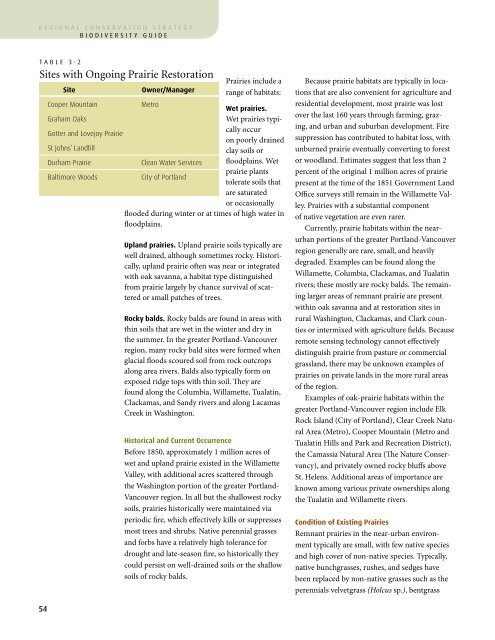Biodiversity Guide - The Intertwine
Biodiversity Guide - The Intertwine
Biodiversity Guide - The Intertwine
You also want an ePaper? Increase the reach of your titles
YUMPU automatically turns print PDFs into web optimized ePapers that Google loves.
egional conservation strategybiodiversity guideChapter 3 Major Habitat Types of the RegionTable 3-2Sites with Ongoing Prairie RestorationSiteOwner/ManagerPrairies include arange of habitats:Cooper MountainGraham OaksGotter and Lovejoy PrairieSt Johns’ LandfillDurham PrairieBaltimore WoodsMetroClean Water ServicesCity of PortlandWet prairies.Wet prairies typicallyoccuron poorly drainedclay soils orfloodplains. Wetprairie plantstolerate soils thatare saturatedor occasionallyflooded during winter or at times of high water infloodplains.Upland prairies. Upland prairie soils typically arewell drained, although sometimes rocky. Historically,upland prairie often was near or integratedwith oak savanna, a habitat type distinguishedfrom prairie largely by chance survival of scatteredor small patches of trees.Rocky balds. Rocky balds are found in areas withthin soils that are wet in the winter and dry inthe summer. In the greater Portland-Vancouverregion, many rocky bald sites were formed whenglacial floods scoured soil from rock outcropsalong area rivers. Balds also typically form onexposed ridge tops with thin soil. <strong>The</strong>y arefound along the Columbia, Willamette, Tualatin,Clackamas, and Sandy rivers and along LacamasCreek in Washington.Historical and Current OccurrenceBefore 1850, approximately 1 million acres ofwet and upland prairie existed in the WillametteValley, with additional acres scattered throughthe Washington portion of the greater Portland-Vancouver region. In all but the shallowest rockysoils, prairies historically were maintained viaperiodic fire, which effectively kills or suppressesmost trees and shrubs. Native perennial grassesand forbs have a relatively high tolerance fordrought and late-season fire, so historically theycould persist on well-drained soils or the shallowsoils of rocky balds.Because prairie habitats are typically in locationsthat are also convenient for agriculture andresidential development, most prairie was lostover the last 160 years through farming, grazing,and urban and suburban development. Firesuppression has contributed to habitat loss, withunburned prairie eventually converting to forestor woodland. Estimates suggest that less than 2percent of the original 1 million acres of prairiepresent at the time of the 1851 Government LandOffice surveys still remain in the Willamette Valley.Prairies with a substantial componentof native vegetation are even rarer.Currently, prairie habitats within the nearurbanportions of the greater Portland-Vancouverregion generally are rare, small, and heavilydegraded. Examples can be found along theWillamette, Columbia, Clackamas, and Tualatinrivers; these mostly are rocky balds. <strong>The</strong> remaininglarger areas of remnant prairie are presentwithin oak savanna and at restoration sites inrural Washington, Clackamas, and Clark countiesor intermixed with agriculture fields. Becauseremote sensing technology cannot effectivelydistinguish prairie from pasture or commercialgrassland, there may be unknown examples ofprairies on private lands in the more rural areasof the region.Examples of oak-prairie habitats within thegreater Portland-Vancouver region include ElkRock Island (City of Portland), Clear Creek NaturalArea (Metro), Cooper Mountain (Metro andTualatin Hills and Park and Recreation District),the Camassia Natural Area (<strong>The</strong> Nature Conservancy),and privately owned rocky bluffs aboveSt. Helens. Additional areas of importance areknown among various private ownerships alongthe Tualatin and Willamette rivers.Condition of Existing PrairiesRemnant prairies in the near-urban environmenttypically are small, with few native speciesand high cover of non-native species. Typically,native bunchgrasses, rushes, and sedges havebeen replaced by non-native grasses such as theperennials velvetgrass (Holcus sp.), bentgrass(Agrostis sp), tall fescue (Schedonorus phoenix),and meadow foxtail (Alepocurus pratensis) andannuals such as dog-tail (Cynosurus echniatus)and cheatgrass (Bromus sp). Invasive shrubs suchas Himalayan blackberry and Scot’s broom oftendominate unmanaged grassland areas.Remnant plants of prairie habitats, includingrare species, sometimes are found between roadsand fences on public or private property wherethey are threatened by roadside maintenanceactivities. Remaining larger, unplowed areas thatonce were prairie generally have been managedas pasture for domestic animals or as hay fields.Although commercial grassland or pasture mayprovide some habitat benefits for prairie wildlife,many grassland- and prairie-dependent species,such as western meadowlark (Sturnella neglecta),streaked horned lark (Eremophila alpestrisstrigata), Fender’s blue butterfly (Icaricia icariodesfenderi), and Taylor’s checkerspot butterfly(Euphydryas editha taylori), have declined—oftendramatically—in response to habitat loss anddegradation.Important Flora and FaunaFloraNative Willamette Valley prairies have extraordinarilydiverse plant life. Approximately 375 nativegrass and forb species are highly or moderatelydependent on prairie or savanna habitat in thegreater Portland-Vancouver region. <strong>The</strong> followingare some common native grasses found inprairies:n Roemer’s fescue (Festuca roemeri)n California oatgrass (Danthonia californica)n Prairie junegrass (Koeleria macrantha)n Blue wildrye (Elymus glaucus)n Lemmon’s needlegrass(Achnatherum lemmonii)n Tufted hairgrass (Deschampsia cespitosa)n Meadow barley (Hordeum brachyantherum)Dense sedge (Carex densa) also is common.Native forbs that are commonly intermixed withthe grasses include the following:n Fragrant popcorn flower(Plagioborthrys figuratus)n Camas (Camassia quamash ssp. maxima andC. leichtlinii ssp. suksdorfii)n Oregon sunshine (Eriophyllum lanatum)n Slender cinquefoil (Potentilla gracilis)n Meadow checkermallow (Sidalcea campestris)n Heal-all (Prunella vulgaris)n White pussy ears (Calochortus tolmiei)n Oregon Iris (Iris tenax)54 55




